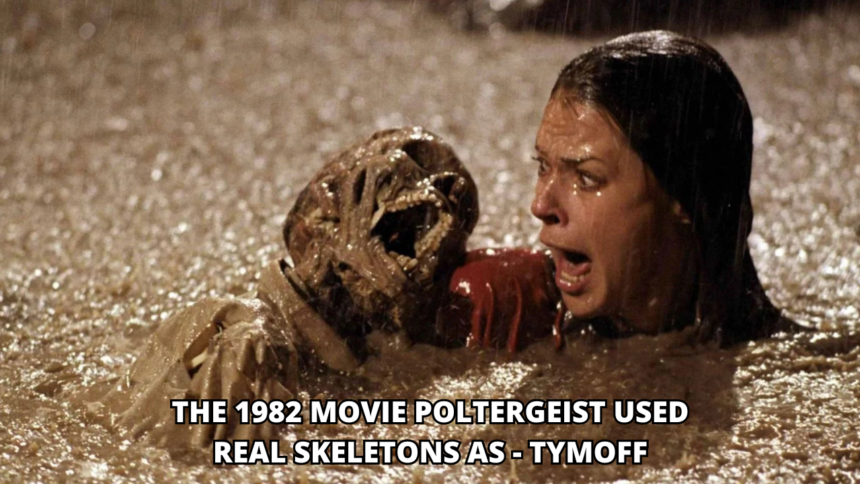Poltergeist, directed by Tobe Hooper and produced by Steven Spielberg, is a landmark film in the horror genre, celebrated for its chilling atmosphere and memorable scares. However, one aspect of its production has sparked considerable controversy: the claim that real human skeletons were used in some scenes, particularly the notorious swimming pool scene. This article delves into the truth behind The 1982 movie poltergeist used real skeletons as – tymoff, exploring its origins, examining the evidence, and understanding its impact on the film and the industry.
Background of Poltergeist (1982)
Poltergeist revolves around the Freeling family, who are haunted by a malevolent spirit that abducts their young daughter, Carol Anne. The film combines supernatural horror with psychological tension, creating a gripping narrative that explores themes of family, fear, and the unknown. The climactic swimming pool scene, where skeletons emerge from the muddy water, is among the film’s most iconic moments.
Production Details
The film was produced by Amblin Entertainment, a company founded by Steven Spielberg, and was released by MGM. Tobe Hooper, known for his work on The Texas Chainsaw Massacre, directed the film, while Spielberg co-wrote the screenplay with Michael Grais and Mark Victor. The film’s special effects were overseen by Richard Edlund, whose team was responsible for the film’s groundbreaking visual effects.
Key Cast and Crew
The film starred JoBeth Williams as Diane Freeling, Craig T. Nelson as Steve Freeling, and Heather O’Rourke as Carol Anne. The cast and crew contributions were pivotal in bringing the terrifying story to life and creating a lasting impact on horror cinema.
The 1982 movie poltergeist used real skeletons as – tymoff in Question
In the film’s pivotal swimming pool scene, Diane Freeling, portrayed by JoBeth Williams, falls into an excavated pool filled with muddy water. As she tries to escape, skeletons begin to rise from the muck, adding to the horror and intensity of the moment. The scene is known for its shocking visual impact and has become one of the most memorable sequences in horror film history.
Context within the Film
The 1982 movie poltergeist used real skeletons as – tymoff scene is crucial in heightening the sense of danger and urgency faced by the Freeling family. It underscores the malevolent presence that haunts them and serves as a turning point in the film’s narrative, emphasizing the supernatural forces at play.
Initial Audience Reactions
Upon its release, the swimming pool scene was both praised for its visceral impact and criticized for its graphic nature. It became a topic of discussion among audiences and critics, contributing to the film’s reputation as a classic horror movie.
Origins of the Real Skeletons Rumor
The rumor that real skeletons were used in the swimming pool scene began circulating shortly after the film’s release. It gained traction from statements made by special effects artist Craig Reardon and various reports suggesting that the skeletons used were authentic human remains.
Key Sources and Testimonies
Craig Reardon, a key figure in the film’s special effects team, confirmed in interviews that real skeletons were used due to their cost-effectiveness and realism compared to plastic replicas. His statements, combined with media coverage, fueled the rumor and contributed to its enduring nature.
Public and Media Reaction
The revelation that real skeletons might have been used shocked the public and media. It sparked debates about the ethics of using human remains in film and contributed to the film’s mystique, influencing how it was perceived by audiences.
Evidence Supporting the Use of Real Skeletons
Craig Reardon’s confirmation that The 1982 movie poltergeist used real skeletons as – tymoff has been a significant piece of evidence supporting the claim. Reardon explained that obtaining real skeletons was cheaper and more realistic than creating plastic replicas, making them a practical choice for the production.
Behind-the-Scenes Accounts
Additional behind-the-scenes accounts from crew members have corroborated Reardon’s statements. These accounts provide insights into the production process and the decisions made regarding the use of real skeletons.
Comparison with Other Films
The use of real skeletons was not unusual in early Hollywood. Films like House on Haunted Hill (1959) and The Exorcist (1973) also reportedly used real human remains, reflecting a broader industry practice of the time.
Counterarguments and Skepticism
Despite the confirmations from special effects artists, some cast and crew members have denied that real skeletons were used. These conflicting statements contribute to the ongoing debate and highlight the complexities of verifying the truth.
Logical and Practical Considerations
Critics argue that using real skeletons poses practical and ethical challenges, including legal concerns and the potential for negative impacts on actors. These considerations raise doubts about the feasibility and appropriateness of using real human remains.
Alternative Explanations
Some suggest that the rumors were exaggerated or misunderstood. They propose that the skeletons used were either replicas or a mix of real and artificial elements, offering alternative explanations for the controversy.
Impact on Cast and Crew
The revelation about the use of real skeletons had a profound emotional impact on the cast and crew. JoBeth Williams, in particular, has expressed her discomfort with the scene, revealing that she was unaware of the skeletons’ authenticity during filming.
Responses and Reflections Over the Years
Over the years, many involved in the film have reflected on the controversy, with some expressing regret and others defending the decisions made during production. The controversy has become a significant part of their public narrative.
Impact on Careers
The controversy surrounding the use of real skeletons has influenced the careers of those involved. It has affected their public image and professional opportunities, highlighting the broader implications of the rumor.
Cultural and Historical Context
In the early days of Hollywood, the use of real skeletons was common due to their availability and cost-effectiveness. This practice reflected the industry’s reliance on practical effects and materials.
Industry Practices in the 1980s
By the 1980s, the use of real skeletons had become less common, with advancements in special effects technology providing more realistic and ethical alternatives. However, some productions still employed real remains for specific effects.
Ethical Considerations
The ethical implications of using real human remains are significant. Issues of consent, respect for the deceased, and the psychological impact on actors are critical factors in the debate over the use of real skeletons in film.
Public Fascination and Urban Legends
The rumor persists due to its sensational nature and the fascination with Hollywood’s darker secrets. It taps into deeper fears and curiosities about the film industry, maintaining public interest.
Influence on Horror Film Culture
The Poltergeist skeleton rumor has influenced how horror films are perceived, adding an extra layer of intrigue and fear. It has become a part of the genre’s mythology and contributed to its lasting impact.
Connection to Other Film Myths
Similar myths and urban legends about other films contribute to the overall fascination with Hollywood’s secrets. These myths create a narrative that adds to the allure and mystery of the film industry.
Legal and Ethical Implications
Modern legal standards require strict adherence to ethical practices in prop use, including the prohibition of using real human remains without proper documentation and consent. These regulations reflect the industry’s commitment to ethical standards.
Ethical Debates Surrounding the Issue
The ethical debates surrounding the use of real skeletons highlight broader concerns about the treatment of human remains and the responsibilities of filmmakers. These debates contribute to the evolving standards in the industry.
Changes in Industry Regulations
The Poltergeist controversy has influenced changes in industry regulations, promoting greater transparency and ethical practices. These changes aim to prevent similar controversies in the future and ensure respectful treatment of human remains.
Interviews and Testimonies
Interviews with Craig Reardon, JoBeth Williams, and other key figures provide valuable insights into the controversy. Their perspectives help to clarify the events surrounding the use of real skeletons and their impact on the film.
Analysis of Conflicting Testimonies
Examining the conflicting testimonies reveals the complexity of the issue and highlights the difficulties in establishing the full truth. This analysis helps to understand the different viewpoints and the reasons behind them.
Recent Discoveries or Revelations
Recent interviews and discoveries may shed new light on the controversy, influencing public perception and adding to the ongoing discussion about the use of real skeletons in Poltergeist.
Media Coverage and Documentation
Media coverage of the Poltergeist skeleton rumor has evolved, with initial sensationalism giving way to more nuanced analyses. This coverage has contributed to the public’s understanding of the controversy.
Documentary Features and Investigative Reports
Documentaries and investigative reports have explored the story in depth, providing detailed analyses and contributing to the ongoing public interest in the film’s production.
Public Response to Media Coverage
The way the media has covered the story affects public perception and understanding of the events. Public response to media coverage highlights the enduring fascination with the Poltergeist skeleton rumor.
The Poltergeist Curse
The “Poltergeist curse” refers to a series of tragic events and deaths among the cast and crew, which some attribute to the use of real skeletons. The curse has become a part of the film’s mystique and legacy.
Connections to the Real Skeletons Rumor
The curse is often linked to the skeletons rumor, adding to the film’s enigmatic reputation. The alleged curse contributes to the broader narrative surrounding Poltergeist and its impact on those involved.
Analysis of the Curse’s Impact on the Film’s Legacy
The curse and the skeletons rumor have intertwined with the film’s legacy, influencing how it is remembered and discussed. The curse adds an extra layer of intrigue and contributes to the film’s lasting impact on horror cinema.
Influence on Modern Filmmaking
The controversy surrounding Poltergeist has impacted how future horror films handle special effects and prop use. Filmmakers have become more aware of ethical considerations and the need for realistic alternatives.
Changes in Special Effects Practices
Advances in technology and materials have made the use of real skeletons unnecessary, leading to more realistic and ethical alternatives. Modern special effects practices reflect a commitment to both realism and ethical standards.
Lessons Learned by the Industry
The Poltergeist controversy has highlighted the importance of transparency and respect in filmmaking practices. The lessons learned from the controversy continue to influence industry standards and practices.
Conclusion on The 1982 movie poltergeist used real skeletons as – tymoff
The question of whether The 1982 movie poltergeist used real skeletons as – tymoff remains a complex and intriguing topic. Evidence supports the use of real remains, but conflicting testimonies and ethical considerations continue to fuel debate. The controversy has had a lasting impact on the film’s legacy and the industry, serving as a reminder of the importance of ethical practices in filmmaking. As we reflect on Poltergeist, we acknowledge both its contribution to horror cinema and the broader lessons it offers about the treatment of human remains in film.
FAQs on The 1982 movie poltergeist used real skeletons as – tymoff
Why did Poltergeist (1982) use real skeletons? The 1982 movie poltergeist used real skeletons as – tymoff was primarily a practical decision based on cost and availability. At the time, real skeletons were cheaper and more realistic compared to plastic replicas.
What proof exists that real skeletons were used in Poltergeist? Statements from special effects artists, behind-the-scenes accounts, and comparisons with other films provide evidence supporting that The 1982 movie poltergeist used real skeletons as – tymoff.
How did the cast and crew react to the use of real skeletons? Reactions varied, with some expressing discomfort and others defending the decision. The controversy has influenced their public perception and careers.
What are the legal implications of using real skeletons in films? Modern legal standards prohibit the use of real human remains without proper documentation and consent, reflecting ethical concerns surrounding such practices.
Is there any truth to the Poltergeist curse? The Poltergeist curse is a widely discussed topic, with alleged connections to the use of real skeletons and a series of tragic events among the cast and crew. The curse remains a part of the film’s mystique and legacy.









